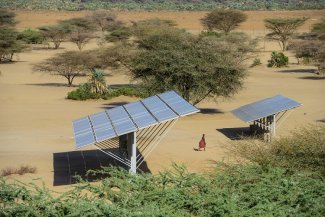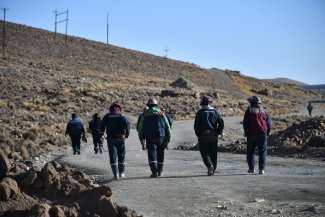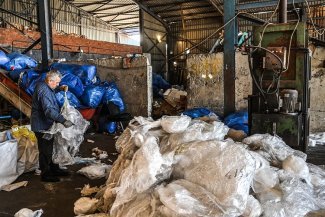It is the second most used resource after water and, like water, it could soon be in short supply. Sand is essential to the society we live in. But current demand is so high that it is being used faster than it can be replenished.
Sand is one of our lesser-known development resources. It is not only used to build our homes, schools, hospitals, roads and cars, but also to produce glass, agricultural fertilisers, computers and electronic chips. Between 40 and 50 billion tonnes are extracted from lakes, rivers and beaches around the world every year. That is the equivalent of 18 kilos per person per day, or a wall 27 metres high and 27 metres wide built all around the globe.
These figures make sand the second most extracted resource on our planet, after water and ahead of fossil fuels. But our reserves are finite and not all types of sand can be used, especially in the construction sector, which is the main consumer of this resource, used to manufacture concrete. Sand from the desert, like that from the Sahara, cannot be used. It is too fine and too smooth. What the world relies on is aggregate, crushed rock, rolled by the waves of the sea, rivers or lakes. And this type of sand is in danger of becoming scarce.
The latest report published by GRID-Geneva (Global Resource Information Database) of the United Nations Environment Programme (UNEP) clearly highlights the need to better manage this resource. Under the heading Sand and Sustainability: Finding New Solutions for Environmental Governance of Global Sand Resources, the report seeks to provide the keys to help prevent the world from running low on sand. “You cannot extract, transport and use such volumes without generating massive environmental and societal impacts. Our recommendations aim at solving this challenge,” says Pascal Peduzzi, director of GRID-Geneva at UNEP.
As the report points out, our use of sand is currently putting our backs against the wall. Josefine Reimer Lynggaard, editor of the report and member of GRID-Geneva, UNEP, tells Equal Times: “We have been talking about the over-extraction of sand and its environmental and social consequences for years. It’s time to start looking at solutions.”
With Africa’s population expected to double by 2050, the migration of rural populations to cities and the growing need for infrastructure such as buildings, roads, schools and hospitals, the demand for sand is accelerating worldwide.
Between 2006 and 2021, China used more sand-based cement than the United States during the whole of the 20th century. It is also a vital resource for small island nations, such as Singapore, in the context of climate change and rising sea levels, and is being used to build sea walls to try to limit the damage. The country’s demand is so great that the sand trade has become a source of serious dispute with its main suppliers – Indonesia, Cambodia and Malaysia. These countries have had to scale back their exports to Singapore as the city-state’s ballooning demand has depleted their stocks.
Threats to the future
The main problem today is poor governance of the resource and weak regulation of its extraction. These shortcomings have serious consequences, which is why the authors of the UN report have called for sand to be recognised as a strategic resource.
“Our societies are literally built on sand. If our entire development depends on sand, it should be recognised as a strategic material,” says Peduzzi. Reimer Lynggaard agrees: “Its monetary value should correspond to the environmental and societal issues surrounding it. Sand is often inexpensive, or it was, at least, prior to Covid, which has led to its overexploitation. By recognising it as a strategic resource, we can ensure that its price reflects its potential impact on the environment and the people affected by its extraction.”
The repercussions of our current sand mining models are undeniably drastic, not least for the environment. Although sand extraction is regulated in European countries and the United States, this is not true elsewhere, especially in the developing countries that heavily rely on this resource, such as Vietnam, Cambodia, India and Kenya.
The extraction of sand from ecosystems where it plays an active role, such as rivers, deltas, coasts and marine environments, leads to increased erosion, salinisation of aquifers and reduced protection against storms at sea. It also destroys vital natural habitats.
In the Ganges in northern India, erosion of the river’s banks has for example destroyed the nesting and breeding habitats of the critically endangered Gharial crocodile, Gavialis gangeticus, of which only around 200 adults remain in the wild in northern India and Nepal. Extracting sand from rivers also changes their shape, contributing to bank erosion and increasing the risk of drought or flooding. And sand mining in shallow waters, especially seabed mining, destabilises extremely fragile ecosystems.
Unregulated sand mining is also having devastating effects on local communities where this activity is a key source of income such as in India, Kenya and Cape Verde, and where it is not only impacting the water supplies of large sections of the population, but also food production, fishing and tourism. In the Mekong Delta, the Vietnamese government estimates that around 500,000 people will have to be moved away from the banks of the river, which are collapsing due to sand extraction.
Helping communities reliant on sand mining and recycling
There is no shortage of solutions to limit our use of sand. But the transition is complex, as its extraction is often the backbone of entire local economies and a vital source of household income. “Many people rely on sand extraction for a living, especially in India, West Africa, and all along coastlines where artisanal sand mining is conducted. And so a ban on sand mining would be too problematic for the people whose livelihoods depend on it, which is why we need to look at other solutions that take them into consideration,” says Reimer Lynggaard.
The UNEP, in its report, stresses that addressing the issue of sand requires social, political and economic transformation in developing countries. And there are several examples that suggest that such a transformation is possible. In Kenya’s Makueni County, sand mining is a long-standing feature of economic life. But it is also the cause of the water shortages suffered by the population, as well as the violence and conflict driven by the fight for control over the activity.
Following major protests in 2018, the county created a Sand Conservation and Utilisation Authority, which has helped better regulate the use of the resource, including local people in its studies, encouraging more responsible use of the resource, and creating more stable jobs for local communities in the process.
Such initiatives not only contribute to more responsible sand use but can also help combat illegal sand mining, which is often a source of tension and violence. In recent years, hundreds of people have died in countries such as Kenya and India in conflicts over sand, and almost 70 countries are believed to be affected by illegal sand mining.
It is now also possible to limit our consumption of sand, for example, by using substitutes such as recycled materials in the construction sector. Almost 90 per cent of the concrete in demolished buildings can, in fact, be recycled without any loss of quality. “Unlike many other raw mineral materials, sand and gravel are recyclable countless times for many of their applications,” explains Peduzzi. Viable alternatives to sand include crushed rock or recycled construction and demolition materials, as well as mineral sand from mine tailings.
Again, there are several examples from around the world showing that change is possible. Mexico City, for instance, has become a trailblazer in this field. A concrete recycling plant has been set up near the Mexican capital to reduce transport distances by 80 per cent and the reuse of demolition waste has become the norm for companies working on construction sites in the city, with new legislation requiring contractors to work with recycling plants that treat the waste properly. In addition, builders are required to prove that recycled materials are used in their construction work, such as recycled aggregates and pre-mixed concrete or asphalt made from recycled materials.
These measures are working and can be used by countries around the world to ensure more responsible sand use and avoid severe global shortages. Yet, in spite of all these solutions, old habits and the idea that sand is an inexhaustible resource seem to be hard to shake. All too often, gravel from the natural environment is preferred over alternative solutions.
And as time runs out to avoid yet another global crisis, even the smallest change can be crucial. “There is no one approach that is a magic solution, but there are many possibilities that we need to build on. The scale of our sand use is such that even a minor change in our use of the resource could have a major impact on the environment and people,” insists Reimer Lynggaard.













